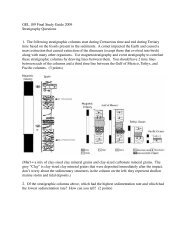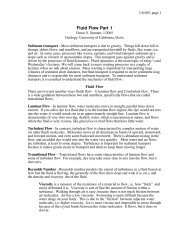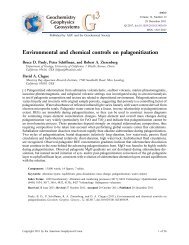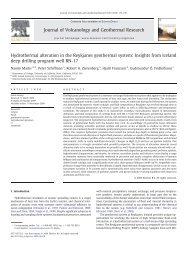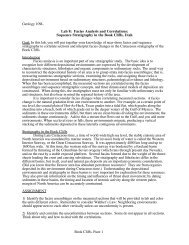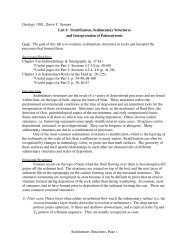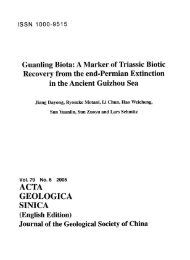Fish-shaped reptiles called ichthyosaurs reigned ... - MyGeologyPage
Fish-shaped reptiles called ichthyosaurs reigned ... - MyGeologyPage
Fish-shaped reptiles called ichthyosaurs reigned ... - MyGeologyPage
Create successful ePaper yourself
Turn your PDF publications into a flip-book with our unique Google optimized e-Paper software.
<strong>Fish</strong>-<strong>shaped</strong> <strong>reptiles</strong> <strong>called</strong> <strong>ichthyosaurs</strong> <strong>reigned</strong> over the oceans<br />
for as long as dinosaurs roamed the land, but only recently have<br />
paleontologists discovered why these creatures were so successful<br />
Picture a late autumn evening some 160 million years ago,during the<br />
Jurassic time period, when dinosaurs inhabited the continents. The<br />
setting sun hardly penetrates the shimmering surface of a vast bluegreen<br />
ocean, where a shadow glides silently among the dark crags of a submerged<br />
volcanic ridge. When the animal comes up for a gulp of evening air, it<br />
calls to mind a small whale—but it cannot be.The first whale will not evolve for another<br />
100 million years.The shadow turns suddenly and now stretches more than<br />
twice the height of a human being. That realization becomes particularly chilling<br />
when its long,tooth-filled snout tears through a school of squidlike creatures.<br />
The remarkable animal is Ophthalmosaurus,one of more than 80 species now<br />
known to have constituted a group of sea monsters <strong>called</strong> the <strong>ichthyosaurs</strong>, or<br />
Rulers of the<br />
Jurassic Seas<br />
by Ryosuke Motani<br />
Copyright 2000 Scientific American, Inc.
ICHTHYOSAURS patrolled the world’s<br />
oceans for 155 million years.<br />
KAREN CARR<br />
www.sciam.com<br />
Scientific American December 2000 53<br />
Copyright 2000 Scientific American, Inc.
SHARKS<br />
AND RAYS<br />
RAY-FINNED<br />
FISHES AMPHIBIANS MAMMALS<br />
LEPIDOSAURS<br />
Snakes Lizards Tuatara<br />
DIAPSIDS<br />
ARCHOSAURS<br />
Crocodiles<br />
Birds<br />
DINOSAURS<br />
ICHTHYOSAURS<br />
TOMO NARASHIMA AND CLEO VILETT<br />
ANCESTRAL<br />
VERTEBRATE<br />
ORIGINS OF ICHTHYOSAURS baffled paleontologists for nearly two<br />
centuries. At times thought to be closely related to everything from fish to<br />
salamanders to mammals, <strong>ichthyosaurs</strong> are now known to belong to the<br />
group <strong>called</strong> diapsids. New analyses indicate that they branched off from<br />
other diapsids at about the time lepidosaurs and archosaurs diverged from<br />
each other—but no one yet knows whether <strong>ichthyosaurs</strong> appeared shortly<br />
before that divergence or shortly after.<br />
fish-lizards. The smallest of these animals<br />
was no longer than a human arm;<br />
the largest exceeded 15 meters. Ophthalmosaurus<br />
fell into the medium-size<br />
group and was by no means the most<br />
aggressive of the lot. Its company would<br />
have been considerably more pleasant<br />
than that of a ferocious Temnodontosaurus,<br />
or “cutting-tooth lizard,” which<br />
sometimes dined on large vertebrates.<br />
When paleontologists uncovered the<br />
first ichthyosaur fossils in the early<br />
1800s, visions of these long-vanished<br />
beasts left them awestruck. Dinosaurs<br />
had not yet been discovered, so every<br />
unusual feature of <strong>ichthyosaurs</strong> seemed<br />
intriguing and mysterious. Examinations<br />
of the fossils revealed that <strong>ichthyosaurs</strong><br />
evolved not from fish but from<br />
land-dwelling animals, which themselves<br />
had descended from an ancient<br />
fish. How, then, did <strong>ichthyosaurs</strong> make<br />
the transition back to life in the water?<br />
To which other animals were they most<br />
related? And why did they evolve bizarre<br />
characteristics, such as backbones that<br />
look like a stack of hockey pucks and<br />
eyes as big around as bowling balls?<br />
Despite these compelling questions,<br />
the opportunity to unravel the enigmatic<br />
transformation from landlubbing<br />
<strong>reptiles</strong> to denizens of the open sea<br />
would have to wait almost two centuries.<br />
When dinosaurs such as Iguanodan<br />
grabbed the attention of paleontologists<br />
in the 1830s, the novelty of<br />
the fish-lizards faded away. Intense interest<br />
in the rulers of the Jurassic seas<br />
resurfaced only a few years ago, thanks<br />
to newly available fossils from Japan<br />
and China. Since then, fresh insights<br />
have come quickly.<br />
Murky Origins<br />
Although most people forgot about<br />
<strong>ichthyosaurs</strong> in the early 1800s, a<br />
few paleontologists did continue to<br />
think about them throughout the 19th<br />
century and beyond. What has been evident<br />
since their discovery is that the<br />
<strong>ichthyosaurs</strong>’ adaptations for life in water<br />
made them quite successful. The<br />
widespread ages of the fossils revealed<br />
that these beasts ruled the ocean from<br />
about 245 million until about 90 million<br />
years ago—roughly the entire era<br />
that dinosaurs dominated the continents.<br />
Ichthyosaur fossils were found<br />
all over the world, a sign that they migrated<br />
extensively, just as whales do today.<br />
And despite their fishy appearance,<br />
<strong>ichthyosaurs</strong> were obviously air-breathing<br />
<strong>reptiles</strong>. They did not have gills, and<br />
the configurations of their skull and jawbones<br />
were undeniably reptilian. What<br />
is more, they had two pairs of limbs<br />
(fish have none), which implied that<br />
their ancestors once lived on land.<br />
Paleontologists drew these conclusions<br />
based solely on the exquisite skeletons<br />
of relatively late, fish-<strong>shaped</strong> <strong>ichthyosaurs</strong>.<br />
Bone fragments of the first<br />
<strong>ichthyosaurs</strong> were not found until 1927.<br />
Somewhere along the line, those early<br />
FACT: The smallest ichthyosaur was shorter than a human arm;<br />
54 Scientific American December 2000 Rulers of the Jurassic Seas<br />
Copyright 2000 Scientific American, Inc.
animals went on to acquire a decidedly<br />
fishy body: stocky legs morphed into<br />
flippers, and a boneless tail fluke and<br />
dorsal fin appeared. Not only were the<br />
advanced, fish-<strong>shaped</strong> <strong>ichthyosaurs</strong><br />
made for aquatic life, they were made<br />
for life in the open ocean, far from<br />
shore. These extreme adaptations to<br />
living in water meant that most of them<br />
had lost key features—such as particular<br />
wrist and ankle bones—that would<br />
have made it possible to recognize their<br />
distant cousins on land. Without complete<br />
skeletons of the very first <strong>ichthyosaurs</strong>,<br />
paleontologists could merely<br />
speculate that they must have looked<br />
like lizards with flippers.<br />
The early lack of evidence so confused<br />
scientists that they proposed almost<br />
every major vertebrate group—<br />
not only <strong>reptiles</strong> such as lizards and<br />
crocodiles but also amphibians and<br />
mammals—as close relatives of <strong>ichthyosaurs</strong>.<br />
As the 20th century progressed,<br />
scientists learned better how to decipher<br />
the relationships among various<br />
animal species. On applying the new<br />
skills, paleontologists started to agree<br />
that <strong>ichthyosaurs</strong> were indeed <strong>reptiles</strong><br />
of the group Diapsida, which includes<br />
snakes, lizards, crocodiles and dinosaurs.<br />
But exactly when <strong>ichthyosaurs</strong><br />
branched off the family tree remained<br />
uncertain—until paleontologists in Asia<br />
recently unearthed new fossils of the<br />
world’s oldest <strong>ichthyosaurs</strong>.<br />
The first big discovery occurred on<br />
the northeastern coast of Honshu, the<br />
main island of Japan. The beach is<br />
dominated by outcrops of slate, the layered<br />
black rock that is often used for<br />
the expensive ink plates of Japanese<br />
calligraphy and that also harbors bones<br />
of the oldest ichthyosaur, Utatsusaurus.<br />
Most Utatsusaurus specimens turn up<br />
fragmented and incomplete, but a<br />
group of geologists from Hokkaido<br />
University excavated two nearly complete<br />
skeletons in 1982. These specimens<br />
eventually became available for<br />
scientific study, thanks to the devotion<br />
of Nachio Minoura and his colleagues,<br />
who spent much of the next 15 years<br />
painstakingly cleaning the slate-encrusted<br />
bones. Because the bones are so fragile,<br />
they had to chip away the rock carefully<br />
with fine carbide needles as they<br />
peered through a microscope.<br />
As the preparation neared its end in<br />
1995, Minoura, who knew of my interest<br />
in ancient <strong>reptiles</strong>, invited me to join<br />
the research team. When I saw the<br />
skeleton for the first time, I knew that<br />
Utatsusaurus was exactly what paleontologists<br />
had been expecting to find for<br />
years: an ichthyosaur that looked like a<br />
lizard with flippers. Later that same year<br />
my colleague You Hailu, then at the Institute<br />
for Vertebrate Paleontology and<br />
Paleoanthropology in Beijing, showed<br />
me a second, newly discovered fossil—<br />
the world’s most complete skeleton of<br />
Chaohusaurus, another early ichthyosaur.<br />
Chaohusaurus occurs in rocks the<br />
same age as those harboring remains of<br />
Utatsusaurus, and it, too, had been<br />
found before only in bits and pieces.<br />
The new specimen clearly revealed the<br />
outline of a slender, lizardlike body.<br />
Utatsusaurus and Chaohusaurus illuminated<br />
at long last where <strong>ichthyosaurs</strong><br />
belonged on the vertebrate family tree,<br />
because they still retained some key features<br />
of their land-dwelling ancestors.<br />
Given the configurations of the skull<br />
and limbs, my colleagues and I think<br />
that <strong>ichthyosaurs</strong> branched off from<br />
the rest of the diapsids near the separation<br />
of two major groups of living <strong>reptiles</strong>,<br />
lepidosaurs (such as snakes and<br />
lizards) and archosaurs (such as crocodiles<br />
and birds). Advancing the familytree<br />
debate was a great achievement,<br />
but the mystery of the <strong>ichthyosaurs</strong>’<br />
evolution remained unsolved.<br />
From Feet to Flippers<br />
Perhaps the most exciting outcome<br />
of the discovery of these two Asian<br />
<strong>ichthyosaurs</strong> is that scientists can now<br />
paint a vivid picture of the elaborate<br />
NEW FOSSILS of the first <strong>ichthyosaurs</strong>,<br />
including Chaohusaurus<br />
(right), have illuminated how these<br />
lizard-<strong>shaped</strong> creatures evolved into<br />
masters of the open ocean, such as<br />
Stenopterygius, shown below with a<br />
baby exiting the birth canal.<br />
RYOSUKE MOTANI (top); STAATLICHES MUSEUM<br />
FÜR NATURKUNDE STUTTGART (bottom)<br />
the largest was longer than a typical city bus<br />
www.sciam.com Scientific American December 2000 55<br />
Copyright 2000 Scientific American, Inc.
Chaohusaurus geishanesis<br />
0.5 to 0.7 meter • Lived 245 million years ago (Early Triassic)<br />
ficiency of the flippers because they are<br />
streamlined in cross section—a shape<br />
impossible to maintain if the digits are<br />
separated.<br />
But examination of fossils ranging<br />
from lizard- to fish-<strong>shaped</strong>—especially<br />
those of intermediate forms—revealed<br />
that the evolution from fins to feet was<br />
not a simple modification of the foot’s<br />
five digits. Indeed, analyses of ichthyosaur<br />
limbs reveal a complex evolutionary<br />
process in which digits were lost,<br />
added and divided. Plotting the shape<br />
of fin skeletons along the family tree of<br />
<strong>ichthyosaurs</strong>, for example, indicates<br />
that fish-<strong>shaped</strong> <strong>ichthyosaurs</strong> lost the<br />
thumb bones present in the earliest <strong>ichthyosaurs</strong>.<br />
Additional evidence comes<br />
from studying the order in which digits<br />
became bony, or ossified, during the<br />
growth of the fish-<strong>shaped</strong> ichthyosaur<br />
Stenopterygius, for which we have specimens<br />
representing various growth<br />
stages. Later, additional fingers appeared<br />
on both sides of the preexisting<br />
ones, and some of them occupied<br />
the position of the lost thumb. Needless<br />
to say, evolution does not always<br />
follow a continuous, directional path<br />
from one trait to another.<br />
Mixosaurus cornalianus<br />
0.5 to 1 meter • Lived 235 million years ago (Middle Triassic)<br />
Ophthalmosaurus icenicus<br />
3 to 4 meters • Lived from 165 million to 150 million years ago (Middle to Late Jurassic)<br />
DORSAL FIN<br />
ANCIENT SKELETONS have helped scientists trace how the slender, lizardlike bodies of<br />
the first <strong>ichthyosaurs</strong> (top) thickened into a fish shape with a dorsal fin and a tail fluke.<br />
TAIL FLUKE<br />
adaptations that allowed their descendants<br />
to thrive in the open ocean. The<br />
most obvious transformation for aquatic<br />
life is the one from feet to flippers. In<br />
contrast to the slender bones in the front<br />
feet of most <strong>reptiles</strong>, all bones in the front<br />
“feet” of the fish-<strong>shaped</strong> <strong>ichthyosaurs</strong><br />
are wider than they are long. What is<br />
more, they are all a similar shape. In<br />
most other four-limbed creatures it is<br />
easy to distinguish bones in the wrist<br />
(irregularly rounded) from those in the<br />
palm (long and cylindrical). Most important,<br />
the bones of fish-<strong>shaped</strong><br />
<strong>ichthyosaurs</strong> are closely packed—without<br />
skin in between—to form a solid<br />
panel. Having all the toes enclosed in a<br />
single envelope of soft tissues would<br />
have enhanced the rigidity of the flippers,<br />
as it does in living whales, dolphins,<br />
seals and sea turtles. Such soft tissues<br />
also improve the hydrodynamic ef-<br />
ED HECK<br />
Backbones Built for Swimming<br />
The new lizard-<strong>shaped</strong> fossils have<br />
also helped resolve the origin of<br />
the skeletal structure of their fish<strong>shaped</strong><br />
descendants. The descendants<br />
have backbones built from concave<br />
vertebrae the shape of hockey pucks.<br />
This shape, though rare among diapsids,<br />
was always assumed to be<br />
typical of all <strong>ichthyosaurs</strong>. But the<br />
new creatures from Asia surprised<br />
paleontologists by having a much<br />
narrower backbone, composed of<br />
vertebrae <strong>shaped</strong> more like canisters<br />
of 35-millimeter film than hockey<br />
pucks. It appeared that the vertebrae<br />
grew dramatically in diameter<br />
and shortened slightly as <strong>ichthyosaurs</strong><br />
evolved from lizard- to fish<strong>shaped</strong>.<br />
But why?<br />
My colleagues and I found the answer<br />
in the swimming styles of living<br />
sharks. Sharks, like <strong>ichthyosaurs</strong>,<br />
come in various shapes and sizes.<br />
Cat sharks are slender and lack a<br />
tall tail fluke, also known as a caudal<br />
fin, on their lower backs, as did<br />
early <strong>ichthyosaurs</strong>. In contrast, mackerel<br />
sharks such as the great white have<br />
thick bodies and a crescent-<strong>shaped</strong> caudal<br />
fin similar to the later fish-<strong>shaped</strong><br />
<strong>ichthyosaurs</strong>. Mackerel sharks swim by<br />
swinging only their tails, whereas cat<br />
sharks undulate their entire bodies. Undulatory<br />
swimming requires a flexible<br />
body, which cat sharks achieve by having<br />
a large number of backbone segments.<br />
They have about 40 vertebrae in<br />
the front part of their bodies—the same<br />
number scientists find in the first <strong>ichthyosaurs</strong>,<br />
represented by Utatsusaurus<br />
and Chaohusaurus. (Modern <strong>reptiles</strong><br />
and mammals have only about 20.)<br />
Undulatory swimmers, such as cat<br />
sharks, can maneuver and accelerate<br />
sufficiently to catch prey in the relatively<br />
shallow water above the continental<br />
shelf. Living lizards also undulate to<br />
swim, though not as efficiently as crea-<br />
FACT: No other reptile group ever evolved a fish-<strong>shaped</strong> body<br />
56 Scientific American December 2000 Rulers of the Jurassic Seas<br />
Copyright 2000 Scientific American, Inc.
CHAOHUSAURUS<br />
CONTINENTAL SHELF<br />
OPHTHALMOSAURUS<br />
KAREN CARR<br />
SWIMMING STYLES—and thus the habitats<br />
(above)—of <strong>ichthyosaurs</strong> changed as<br />
the shape of their vertebrae evolved. The<br />
narrow backbone of the first <strong>ichthyosaurs</strong><br />
suggests that they undulated their bodies<br />
like eels (right). This motion allowed for<br />
the quickness and maneuverability needed<br />
for shallow-water hunting. As the backbone<br />
thickened in later <strong>ichthyosaurs</strong>, the<br />
body stiffened and so could remain still as<br />
the tail swung back and forth (bottom).<br />
This stillness facilitated the energy-efficient<br />
cruising needed to hunt in the open ocean.<br />
CHAOHUSAURUS<br />
BACKBONE SEGMENT<br />
tures that spend all their time at sea. It<br />
is logical to conclude, then, that the first<br />
<strong>ichthyosaurs</strong>—which looked like cat<br />
sharks and descended from a lizardlike<br />
ancestor—swam in the same fashion<br />
and lived in the environment above the<br />
continental shelf.<br />
Undulatory swimming enables predators<br />
to thrive near shore, where food is<br />
abundant, but it is not the best choice<br />
for an animal that has to travel long distances<br />
to find a meal. Offshore predators,<br />
which hunt in the open ocean<br />
where food is less concentrated, need a<br />
more energy-efficient swimming style.<br />
Mackerel sharks solve this problem by<br />
having stiff bodies that do not undulate<br />
as their tails swing back and forth. A<br />
crescent-<strong>shaped</strong> caudal fin, which acts<br />
as an oscillating hydrofoil, also improves<br />
their cruising efficiency. <strong>Fish</strong>-<strong>shaped</strong> <strong>ichthyosaurs</strong><br />
had such a caudal fin, and<br />
their thick body profile implies that they<br />
probably swam like mackerel sharks.<br />
Inspecting a variety of shark species<br />
reveals that the thicker the body from<br />
top to bottom, the larger the diameter<br />
of the vertebrae in the animal’s trunk. It<br />
seems that sharks and <strong>ichthyosaurs</strong><br />
solved the flexibility problem resulting<br />
from having high numbers of body segments<br />
in similar ways. As the bodies of<br />
<strong>ichthyosaurs</strong> thickened over time, the<br />
number of vertebrae stayed about the<br />
same. To add support to the more voluminous<br />
body, the backbone became at<br />
least one and a half times thicker than<br />
those of the first <strong>ichthyosaurs</strong>. As a consequence<br />
of this thickening, the body<br />
OPHTHALMOSAURUS<br />
became less flexible, and the individual<br />
vertebrae acquired their hockey-puck<br />
appearance.<br />
Drawn to the Deep<br />
The <strong>ichthyosaurs</strong>’ invasion of open<br />
water meant not only a wider coverage<br />
of surface waters but also a deeper<br />
exploration of the marine environment.<br />
We know from the fossilized stomach<br />
contents of fish-<strong>shaped</strong> <strong>ichthyosaurs</strong><br />
that they mostly ate squidlike creatures<br />
known as dibranchiate cephalopods.<br />
Squid-eating whales hunt anywhere<br />
from about 100 to 1,000 meters deep<br />
and sometimes down to 3,000 meters.<br />
The great range in depth is hardly surprising<br />
considering that food resources<br />
are widely scattered below about 200<br />
meters. But to hunt down deep, whales<br />
and other air-breathing divers have to<br />
go there and get back to the surface in<br />
one breath—no easy task. Reducing energy<br />
use during swimming is one of the<br />
best ways to conserve precious oxygen<br />
stored in their bodies. Consequently,<br />
deep divers today have streamlined<br />
shapes that reduce drag—and so did<br />
fish-<strong>shaped</strong> <strong>ichthyosaurs</strong>.<br />
KAREN CARR; ADRIENNE SMUCKER (vertebrae)<br />
www.sciam.com Scientific American December 2000 57<br />
Copyright 2000 Scientific American, Inc.
APPROXIMATE MAXIMUM<br />
DIAMETER OF EYE:<br />
AFRICAN ELEPHANT<br />
5 CENTIMETERS<br />
BLUE WHALE<br />
15 CENTIMETERS<br />
OPHTHALMOSAURUS<br />
23 CENTIMETERS<br />
GIANT SQUID<br />
25 CENTIMETERS<br />
TEMNODONTOSAURUS<br />
26 CENTIMETERS<br />
ICHTHYOSAUR EYES were surprisingly large. Analyses<br />
of doughnut-<strong>shaped</strong> eye bones <strong>called</strong> sclerotic rings<br />
reveal that Ophthalmosaurus had the largest eyes relative<br />
to body size of any adult vertebrate, living or extinct, and<br />
that Temnodontosaurus had the biggest eyes, period.<br />
The beige shape in the background is the size of an Ophthalmosaurus<br />
sclerotic ring. The photograph depicts a<br />
well-preserved ring from Stenopterygius.<br />
Characteristics apart from diet and<br />
body shape also indicate that at least<br />
some fish-<strong>shaped</strong> <strong>ichthyosaurs</strong> were deep<br />
divers. The ability of an air-breathing<br />
diver to stay submerged depends roughly<br />
on its body size: the heavier the diver,<br />
the more oxygen it can store in its muscles,<br />
blood and certain other organs—<br />
and the slower the consumption of oxygen<br />
per unit of body mass. The evolution<br />
of a thick, stiff body increased the<br />
volume and mass of fish-<strong>shaped</strong> <strong>ichthyosaurs</strong><br />
relative to their predecessors. Indeed,<br />
a fish-<strong>shaped</strong> ichthyosaur would<br />
have been up to six times heavier than a<br />
lizard-<strong>shaped</strong> ichthyosaur of the same<br />
body length. <strong>Fish</strong>-<strong>shaped</strong> <strong>ichthyosaurs</strong><br />
also grew longer, further augmenting<br />
their bulk. Calculations based on<br />
the aerobic capacities of today’s<br />
air-breathing divers (mostly mammals<br />
and birds) indicate that an<br />
animal the weight of fish-<strong>shaped</strong><br />
Ophthalmosaurus, which was<br />
about 950 kilograms, could<br />
hold its breath for at least 20<br />
minutes. A conservative estimate<br />
suggests, then, that Ophthalmosaurus<br />
could easily have<br />
dived to 600 meters—possibly<br />
even 1,500 meters—and returned<br />
to the surface in that<br />
time span.<br />
Bone studies also indicate<br />
that fish-<strong>shaped</strong> <strong>ichthyosaurs</strong><br />
were deep divers. Limb bones<br />
and ribs of four-limbed terrestrial<br />
animals include a dense outer<br />
shell that enhances the strength<br />
needed to support a body on land.<br />
But that dense layer is heavy. Because<br />
aquatic vertebrates are fairly buoyant<br />
in water, they do not need the extra<br />
strength it provides. In fact, heavy bones<br />
(which are little help for oxygen storage)<br />
can impede the ability of deep divers to<br />
return to the surface. A group of French<br />
biologists has established that modern<br />
deep-diving mammals solve that problem<br />
by making the outer shell of their<br />
bones spongy and less dense. The same<br />
type of spongy layer also encases the<br />
bones of fish-<strong>shaped</strong> <strong>ichthyosaurs</strong>, which<br />
implies that they, too, benefited from<br />
lighter skeletons.<br />
Perhaps the best evidence for the<br />
deep-diving habits of later <strong>ichthyosaurs</strong><br />
is their remarkably large eyes, up to 23<br />
TOMO NARASHIMA ( animals); EDWARD BELL (sclerotic ring); RYOSUKE MOTANI (photograph)<br />
FACT: Their eyes were the largest of any animal, living or dead<br />
58 Scientific American December 2000 Rulers of the Jurassic Seas<br />
Copyright 2000 Scientific American, Inc.
SMALL ISLAND in northeast Japan<br />
turned out to harbor two almost<br />
complete skeletons of Utatsusaurus,<br />
the oldest ichthyosaur.<br />
centimeters across in the case of<br />
Ophthalmosaurus. Relative to<br />
body size, that fish-<strong>shaped</strong> ichthyosaur<br />
had the biggest eyes of<br />
any animal ever known.<br />
The size of their eyes also suggests<br />
that visual capacity improved<br />
as <strong>ichthyosaurs</strong> moved up<br />
the family tree. These estimates<br />
are based on measurements of the<br />
sclerotic ring, a doughnut-<strong>shaped</strong><br />
bone that was embedded in their<br />
eyes. (Humans do not have such a<br />
ring—it was lost in mammalian<br />
ancestors—but most other vertebrates<br />
have bones in their eyes.) In<br />
the case of <strong>ichthyosaurs</strong>, the ring<br />
presumably helped to maintain<br />
the shape of the eye against the<br />
forces of water passing by as the animals<br />
swam, regardless of depth.<br />
The diameter of the sclerotic ring<br />
makes it possible to calculate the eye’s<br />
minimum f-number—an index, used to<br />
rate camera lenses, for the relative<br />
brightness of an optical system. The<br />
lower the number, the brighter the image<br />
and therefore the shorter the exposure<br />
time required. Low-quality lenses have a<br />
value of f/3.5 and higher; high-quality<br />
lenses have values as low as f/1.0. The f-<br />
number for the human eye is about 2.1,<br />
whereas the number for the eye of a nocturnal<br />
cat is about 0.9. Calculations suggest<br />
that a cat would be capable of seeing<br />
at depths of 500 meters or greater in<br />
most oceans. Ophthalmosaurus also<br />
had a minimum f-number of about 0.9,<br />
but with its much larger eyes, it probably<br />
could outperform a cat.<br />
Gone for Good<br />
Many characteristics of <strong>ichthyosaurs</strong>—including<br />
the shape of<br />
their bodies and backbones, the size of<br />
their eyes, their aerobic capacity, and<br />
their habitat and diet—seem to have<br />
changed in a connected way during<br />
their evolution, although it is not possible<br />
to judge what is the cause and what<br />
is the effect. Such adaptations enabled<br />
<strong>ichthyosaurs</strong> to reign for 155 million<br />
years. New fossils of the earliest of<br />
these sea dwellers are now making it<br />
clear just how they evolved so successfully<br />
for aquatic life, but still no one<br />
knows why <strong>ichthyosaurs</strong> went extinct.<br />
RYOSUKE MOTANI<br />
Loss of habitat may have clinched the<br />
final demise of lizard-<strong>shaped</strong> <strong>ichthyosaurs</strong>,<br />
whose inefficient, undulatory<br />
swimming style limited them to nearshore<br />
environments. A large-scale drop<br />
in sea level could have snuffed out these<br />
creatures along with many others by<br />
eliminating their shallow-water niche.<br />
<strong>Fish</strong>-<strong>shaped</strong> <strong>ichthyosaurs</strong>, on the other<br />
hand, could make a living in the open<br />
ocean, where they would have had a<br />
better chance of survival. Because their<br />
habitat never disappeared, something<br />
else must have eliminated them. The<br />
period of their disappearance roughly<br />
corresponds to the appearance of advanced<br />
sharks, but no one has found<br />
direct evidence of competition between<br />
the two groups.<br />
Scientists may never fully explain the<br />
extinction of <strong>ichthyosaurs</strong>. But as paleontologists<br />
and other investigators continue<br />
to explore their evolutionary history,<br />
we are sure to learn a great deal<br />
more about how these fascinating creatures<br />
lived.<br />
SA<br />
The Author<br />
RYOSUKE MOTANI, who was born in Tokuyama, Japan, is a researcher in the department<br />
of paleobiology at the Royal Ontario Museum in Toronto. As a child he found<br />
<strong>ichthyosaurs</strong> uninteresting. (“They looked too ordinary in my picture books,” he recalls.)<br />
But his view changed during his undergraduate years at the University of Tokyo, after a paleontology<br />
professor allowed him to study the only domestic reptilian fossil they had: an<br />
ichthyosaur. “I quickly fell in love with these noble beasts,” he says. Motani went on to explore<br />
ichthyosaur evolution for his doctoral degree from the University of Toronto in 1997.<br />
A fellowship from the Miller Institute then took him to the University of California, Berkeley,<br />
for postdoctoral research. He moved back to Canada in September 1999.<br />
Further Information<br />
Vertebrate Paleontology and Evolution. R. L. Carroll. Freeman, San Francisco, 1987.<br />
Dinosaurs, Spitfires, and Sea Dragons. Christopher McGowan. Harvard University<br />
Press, 1991.<br />
Eel-like Swimming in the Earliest Ichthyosaurs. Ryosuke Motani, You Hailu and<br />
Christopher McGowan in Nature, Vol. 382, pages 347–348; July 25, 1996.<br />
Ichthyosaurian Relationships Illuminated by New Primitive Skeletons from<br />
Japan. Ryosuke Motani, Nachio Minoura and Tatsuro Ando in Nature, Vol. 393, pages<br />
255–257; May 21, 1998.<br />
Large Eyeballs in Diving Ichthyosaurs. Ryosuke Motani, Bruce M. Rothschild and<br />
William Wahl, Jr., in Nature, Vol. 402, page 747; December 16, 1999.<br />
Ryosuke Motani’s Web site: www.ucmp.berkeley.edu/people/motani/ichthyo/<br />
www.sciam.com Scientific American December 2000 59<br />
Copyright 2000 Scientific American, Inc.



